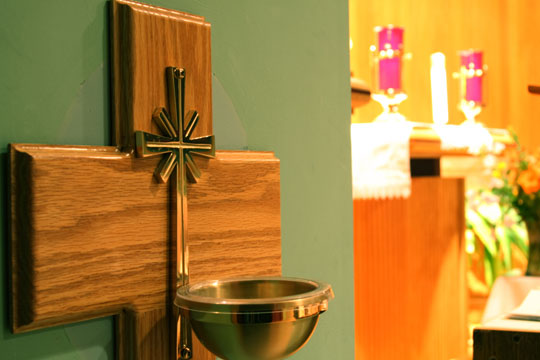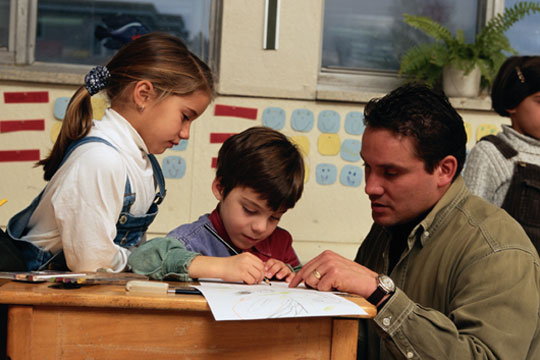
The second of the Six Tasks of Catechesis is liturgical education, or in terms of the remembering phrase HELP ME, expressing our faith. Listen to our bishops:
Since Christ is present in the sacraments, the believer comes to know Christ in the liturgical celebrations of the Church and is drawn into communion with him…Catechesis should promote “an active, conscious genuine participation in the liturgy of the Church” (NDC 20).
Liturgical education calls for preparation before the sacrament is received and for enrichment afterwards. The entire fifth chapter of the NDC provides a framework for carrying this out with specifics for each of the sacraments. Take some time to read it over and reflect on the strengths of your program and where more work needs to be done.
Part two of the CCC is another source to deepen knowledge of sacramental teachings. Take some time to reflect on how you can make your own participation in liturgy more “active, conscious, and genuine,” and what in-services could be offered for your catechists.
How Do We Promote Liturgical Education in the Classroom?
Your director guides, especially for sacramental catechesis, provide background theology, parent and Confirmation sponsor sessions, retreat formats, and much more. Liturgy connections are found throughout the catechist manuals. Talk with catechists about ways they can highlight these ideas.
Here are a few of the general principles for sacramental catechesis from Chapter 5 of the NDC (35B6) and some practical thoughts on implementing them. Sacramental catechesis…
- Is lifelong, intended for all members and takes place within and involves the whole community.
Ongoing adult faith formation is a topic in itself, so let me just address a few small pieces. Be sure that part of the parent sessions is directed toward enriching adult understanding of the sacraments. Get the community involved. Look to the RCIA for a model. How many times are catechumens connected to the Sunday liturgies? The community is actively called to welcome them. How can we do this with the youth? In our parish, a blessing for families at Mass begins the preparation. Parents present their children with crosses for their rooms. First Communicants get autographs of the various liturgical ministers and receive First Holy Communion during regular weekend liturgies. We also invite a deacon or priest to talk about or enact the sacraments. Classes make cards for shut-ins and gifts for the Confirmation candidates. What are you doing in your parish to make these community connections?
- Involves parents in the preparation of their children for the sacraments.
Are you using materials with strong parent components, including parent sessions that provide adult formation and give them clear, doable tasks at which they can succeed? Picture the first meeting with the second-grade parents. They may come in nervous, embarrassed, or defensive, since they don’t know what they could possibly say to their children about Reconciliation. I begin the session by thanking them for all the work they have already done in preparing their children for First Reconciliation. I then tell them that they have been preparing their children for years, since their children were preschoolers. I then explain that when they had their children think about what they did wrong (time outs), they were teaching them to examine their consciences. When their children had to admit they had done something with no “buts” about what others did, they taught confession. When they had the children work at cleaning up the mess or doing something nice for the person hurt, they were teaching penance. When they had their children say, “I’m sorry,” they taught contrition. When they didn’t hold failings over their children’s heads, they taught reconciliation. In the weeks ahead, together we help their children see that Reconciliation isn’t something strange and scary, but it’s turning to God for forgiveness, just like they have been doing at home. We can see the change in the parents’ attitudes. Now they are ready to get involved, because they were affirmed. Later, giving parents a children’s missal so they can assist their children in learning the prayers and understanding the Mass makes the classroom teachings real and prepares them to actively participate.
- Focuses primarily on the symbols, rituals, and prayers of each sacrament.
A key aspect of liturgical education is guiding the students to “active, conscious, and genuine” participation. People can’t participate if they don’t know what is happening or what to say. The sacramental preparation books try to teach the rite—the words and actions as well as their meanings. However, learning about the Mass or any of the sacraments is different from experiencing them. Using the symbols and “acting” out a sacrament so the children can see, feel, and smell what it looks like adds a whole different dimension.
- Enables the believer to reflect on the meaning of the sacrament through an experience of mystagogia following the celebration.
Those who have worked with the RCIA may recognize this term mystagogia as referring to the period after Easter when we are called to unwrap the Easter experience with the newly received and help them enter fully into the parish community. We can and need to do mystagogia with our children. Look at the scope and sequence for the grades following sacrament years. Lessons on the sacraments are found throughout the grade levels. There is a temptation to skip these lessons since the children already “got” it, but don’t. This is an opportunity to go back and deepen and refresh their understanding.
—
Bill Smith has served as a catechetical leader for 40 years in a variety of parish settings, mostly within the Archdiocese of San Antonio. Bill received his Masters in Religious Studies from the University of the Incarnate Word. He has served on a variety of archdiocesan catechetical committees and is an instructor for the archdiocesan catechist formation program.



Leave a Reply